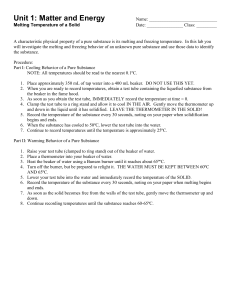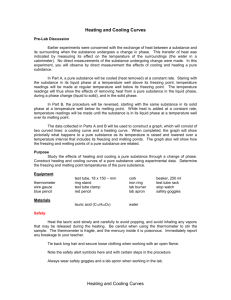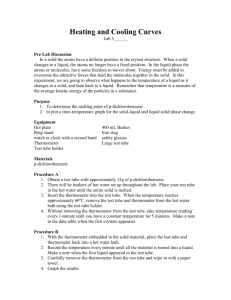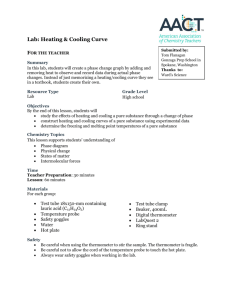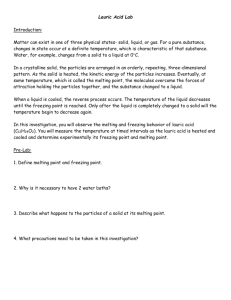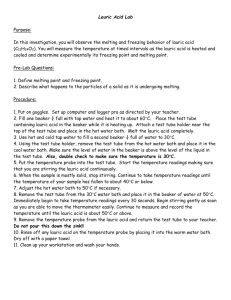Heating & Cooling Solid Acid: Chemistry Lab Procedure
advertisement
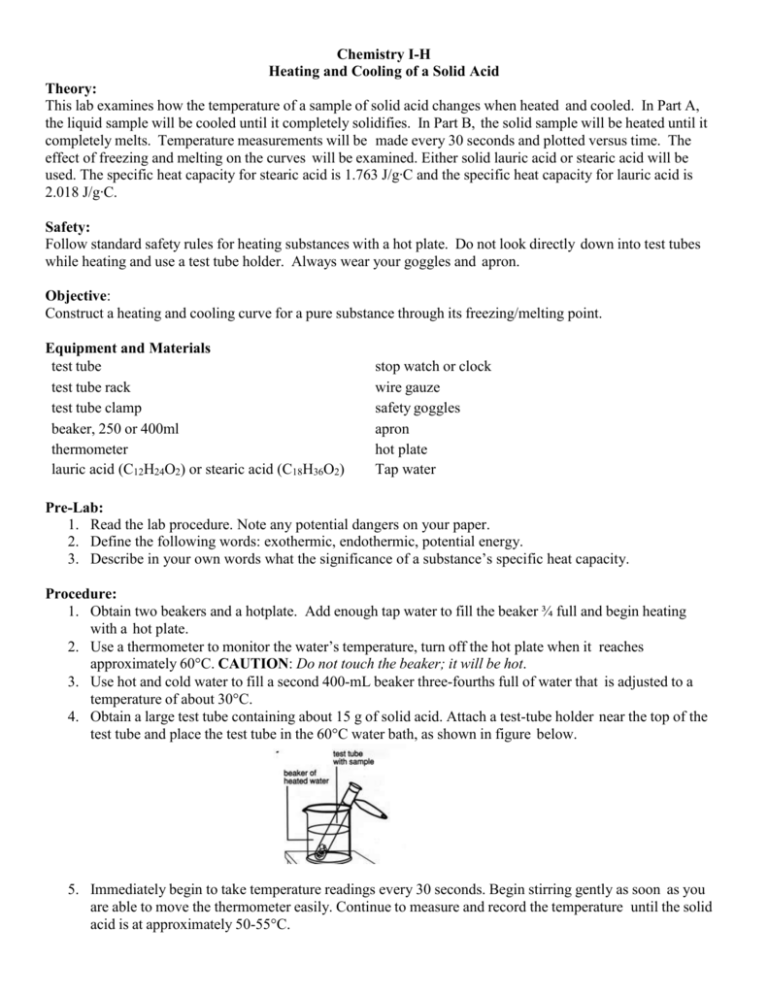
Chemistry I-H Heating and Cooling of a Solid Acid Theory: This lab examines how the temperature of a sample of solid acid changes when heated and cooled. In Part A, the liquid sample will be cooled until it completely solidifies. In Part B, the solid sample will be heated until it completely melts. Temperature measurements will be made every 30 seconds and plotted versus time. The effect of freezing and melting on the curves will be examined. Either solid lauric acid or stearic acid will be used. The specific heat capacity for stearic acid is 1.763 J/g∙C and the specific heat capacity for lauric acid is 2.018 J/g∙C. Safety: Follow standard safety rules for heating substances with a hot plate. Do not look directly down into test tubes while heating and use a test tube holder. Always wear your goggles and apron. Objective: Construct a heating and cooling curve for a pure substance through its freezing/melting point. Equipment and Materials test tube test tube rack test tube clamp beaker, 250 or 400ml thermometer lauric acid (C12H24O2) or stearic acid (C18H36O2) stop watch or clock wire gauze safety goggles apron hot plate Tap water Pre-Lab: 1. Read the lab procedure. Note any potential dangers on your paper. 2. Define the following words: exothermic, endothermic, potential energy. 3. Describe in your own words what the significance of a substance’s specific heat capacity. Procedure: 1. Obtain two beakers and a hotplate. Add enough tap water to fill the beaker ¾ full and begin heating with a hot plate. 2. Use a thermometer to monitor the water’s temperature, turn off the hot plate when it reaches approximately 60°C. CAUTION: Do not touch the beaker; it will be hot. 3. Use hot and cold water to fill a second 400-mL beaker three-fourths full of water that is adjusted to a temperature of about 30°C. 4. Obtain a large test tube containing about 15 g of solid acid. Attach a test-tube holder near the top of the test tube and place the test tube in the 60°C water bath, as shown in figure below. 5. Immediately begin to take temperature readings every 30 seconds. Begin stirring gently as soon as you are able to move the thermometer easily. Continue to measure and record the temperature until the solid acid is at approximately 50-55°C. 6. As the solid begins to melt, place a thermometer into the test tube and stir carefully. CAUTION: The thermometer is fragile. Do not bang it against the sides of the test tube or force it through the solid acid crystals. Continue heating until the temperature of the melted solid acid is 55°C or higher. 7. Using the test-tube holder, remove the test tube from the 60°C water bath and place it in the 30°C water bath. Make sure that the level of the water in the beaker is above the level of the liquid in the test tube. 8. Gently stir the liquid with the thermometer. Begin taking temperature readings every 30 seconds. (One lab partner should stir and read the thermometer, while the other partner watches the clock and records the temperature readings.) Record the temperature on your data sheet to the nearest 0.5°C. Remember to record qualitative observations, as well. 9. When the sample is mostly solid, stop stirring. Continue to take temperature readings until the temperature of your sample has fallen below 40°C. 10. Clean up your work area and wash your hands before leaving the laboratory. Calculations: Graph temperature (y-axis) versus time (x-axis) for both the heating and cooling curves on the same set of axes. Use different symbols or colors for each. Questions: 1. Determine the freezing point of the acid from your cooling curve and explain. 2. Determine the melting point of the acid from your heating curve and explain. 3. How do the melting and freezing points compare using your data? Theoretically, how should they compare? Which data do you think is more reliable and explain why? 4. What phase changes are exothermic? How is potential energy changing? 5. What phase changes are endothermic? How is potential energy changing? 6. How much energy was necessary to melt the acid? Use calculations.

